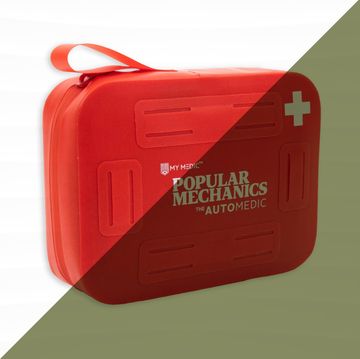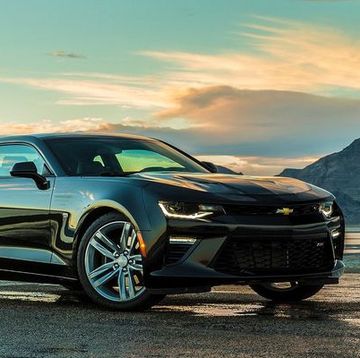It's a straightforward question: How many miles can a fire-breathing beast like the new 2014 Chevrolet Corvette eke out of a gallon of gasoline? Back in 2009 I took the previous-generation C6 Corvette coupe on a mileage loop and it returned an astonishing 32.8 mpg. The new C7 Corvette promised to be even better.
The C7 coupe takes all the fuel economy advantages of the C6 and stretches them. For instance, the C6's 436-hp LS3 6.2-liter V-8 engine was rich in low-end torque, so it didn't need to turn very fast to sustain speed, but it lacked some of the fuel-saving tech we have now. The C7's new 460-hp LT1 version of the same-size V-8 has the new tricks, including variable valve timing, direct fuel injection, and a cylinder deactivation system that has the engine firing only four cylinders under light loads.
Plus, where the sixth gear in the C6's six-speed manual transmission was a 0.50:1 overdrive, the seventh gear in the C7's manual transmission is an even deeper 0.42:1 overdrive. And the low rolling resistance Michelin Pilot Super Sport run-flat tires that the C7 wears are more advanced than the C6's Goodyears. The C7's only apparent disadvantage compared with the C6 I drove for PopMech in 2009 is that, according to GM, it weighs 3298 pounds. That's 81 more than the old model.
The 2009 Corvette carried EPA fuel economy ratings of 16 mpg in the city and 26 mpg on the highway. The 2014 Corvette scored 17/29 mpg. So going into the test, I figured the C7 would return around 35 or 36 mpg.
The Test
For comparison's sake I strove to duplicate the 2009 test as closely as possible. Chevrolet provided a C7 Corvette coupe equipped with a seven-speed manual transmission, Z51 performance package, performance exhaust system, magnetic ride control, and a carbon-fiber removable roof panel. That's close to how the C6 we used in 2009 was equipped, minus the carbon-fiber part.
The route was almost the same: We started at the same Shell service station in Santa Barbara, Calif., and then proceeded up U.S. Route 101 north to the city of Santa Maria and back to the same station. I shortened the route slightly, however, since my turnaround point in Santa Maria has grown more congested with traffic over the last five years. This time I headed back from sleepier Orcutt, just south of Santa Maria, knocking about 18 miles off the total trip.
Using the Vette's cruise control, I maintained a steady 55 mph on the freeway—that's 10 mph below the 65 mph posted speed limit. The Corvette's windows were up, the air conditioning was off, the air vents were open, and the drive mode selector was left in Eco for maximum efficiency. There was no wind the Monday morning of our drive in late February, the temperature was in the mid-60s, traffic was light, and I was the same driver who had been behind the wheel during the 2009 test.
Filling the C7's 18.5-gallon tank with 91-octane fuel without topping off, I entered the 101's northbound traffic flow as gently as I could. That meant a light throttle and upshifting at 2200 rpm. When the car reached 55 mph I skipped from fourth to seventh gear and engaged the cruise control. I played Badfinger songs on my iPhone on the way up to Santa Maria and listed to the Doobie Brothers on the way back down, though I shut the music off and tried to hear the engine dancing between four- and eight-cylinder operation for extended periods.
I have to tell you: There are few things more frustrating than being behind the wheel of a car that can hit 190 mph as it motorboats along in the slow lane being passed by both Greyhound buses and minivans full of actual greyhounds.
The Results
Both the 2009 C6 and the 2014 C7 Corvettes were equipped with 3.42:1 final drive ratios, but the deeper overdrive in the new car meant the new car's engine was turning slower in the test. Where the C6's LS3 ran at about 1300 rpm at 55 mph, the C7's LT1 needed only 1100 rpm to maintain the same easygoing pace. There was the slightest drop in exhaust note when the LT1 would deactivate half its cylinders. But otherwise, the whole drive was utterly uneventful.
Even going up the grade near Nojoqui Falls, the LT1 never stumbled, strained, or begged for a downshift. Evidently, this is a car that not only will rip from 0 to 60 in 3.9 seconds and consume the quarter-mile in a scalding 12.2 seconds, but also cruise along at low speed like an old Buick Park Avenue with radar lock on all-you-can-eat shrimp night at Red Lobster.
As I pulled up to the same pump at which I had initially filled the Corvette, the trip computer showed that I had traveled 124.7 miles at an average speed of 53 mph and consumed fuel at the rate of 34.0 mpg. Impressive. But during the 2009 test the C6 Corvette's onboard computer had proved conservative: It indicated only 30.5 mpg before refueling bumped that number up. So I filled up the new Corvette; it took only 3.34 gallons to refuel the C7 after the trip. That's a stunning 37.3 mpg over that course, almost 14 percent more parsimonious than the mileage performance turned in by the 2009 car.
Dang.
The Lesson
This is hardly a definitive test; it's a simple, back-of-the-envelope evaluation. And an experienced hypermiler using every trick in the book could easily top it—I'd guess they could achieve 40 mpg on the same route. Still, 37.3 mpg is a mind-boggling achievement for a car of such towering performance ability.
All of this reinforces what I learned five years ago. First, that conservative driving pays off in significantly reduced fuel consumption. Second, that the Corvette remains a singular achievement in the history of sports cars, mixing overwhelming performance and economy in a way no other sports car even approaches. And third, that driving a Corvette under cruise control at 55 mph is booooring.

John Pearley Huffman has been writing about cars since 1990 and is getting okay at it. Besides Car and Driver, his work has appeared in the New York Times and more than 100 automotive publications and websites. A graduate of UC Santa Barbara, he still lives near that campus with his wife and two children. He owns a pair of Toyota Tundras and two Siberian huskies. He used to have a Nova and a Camaro.














